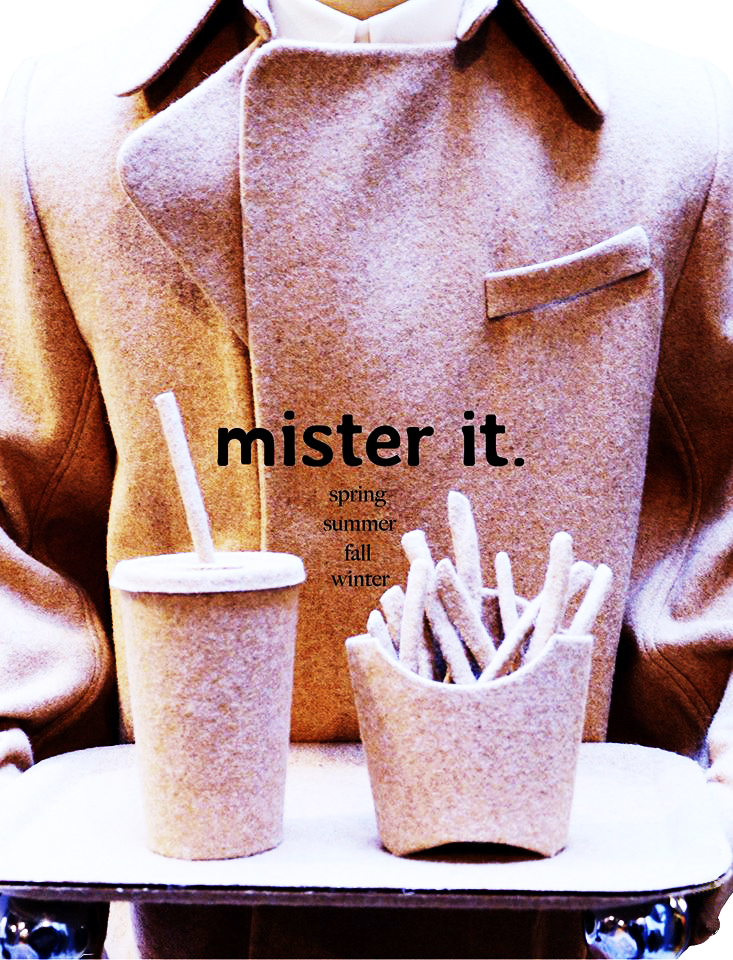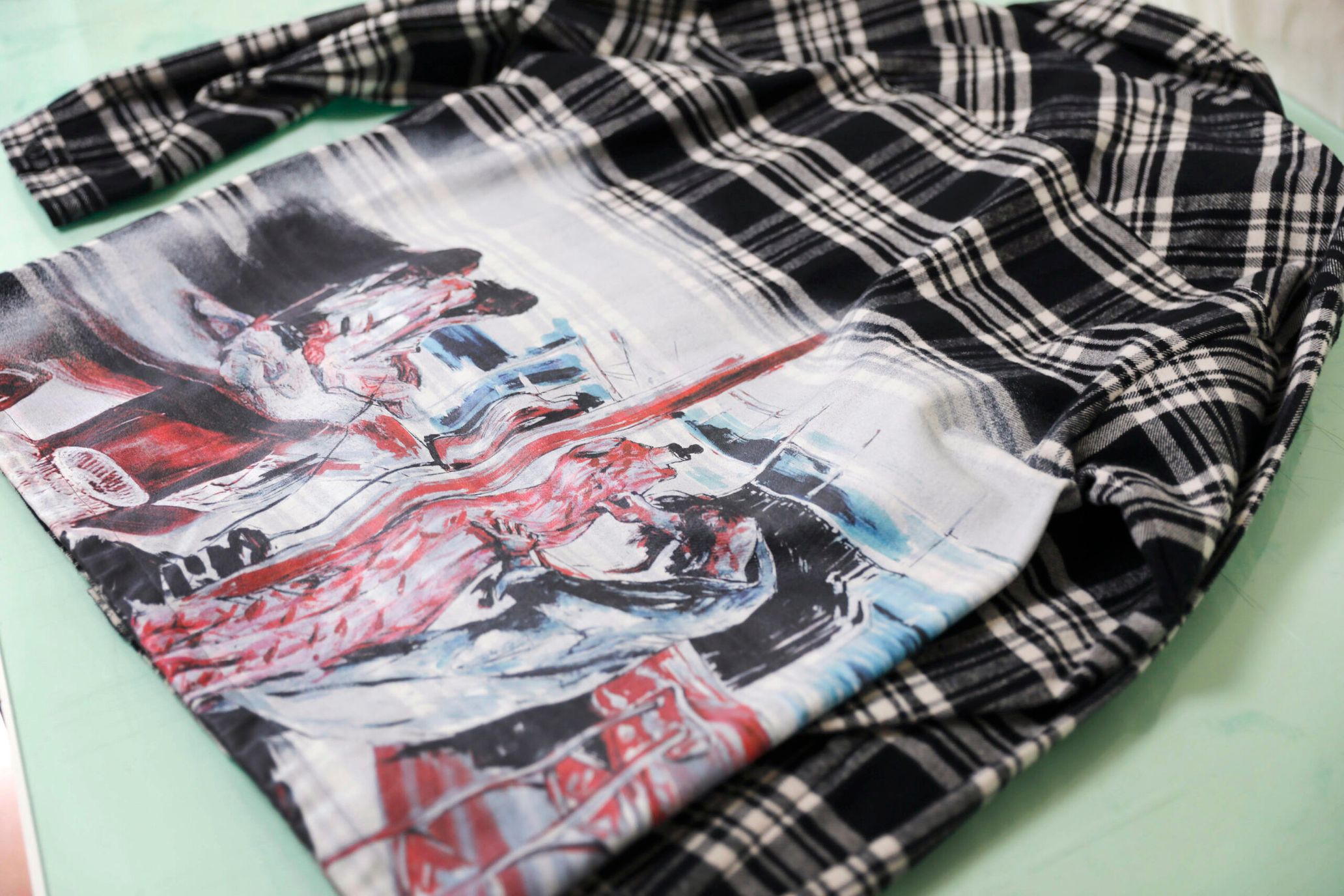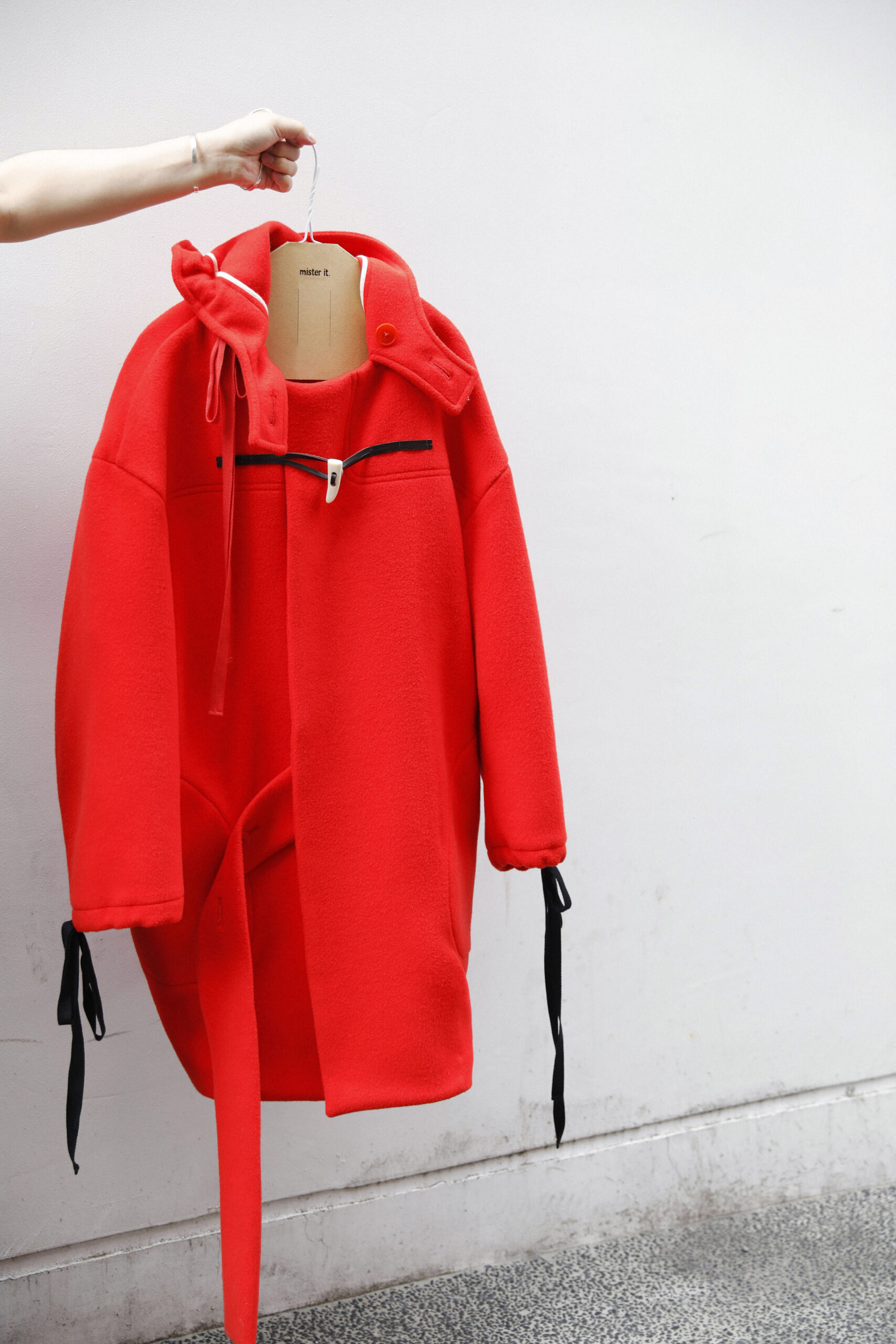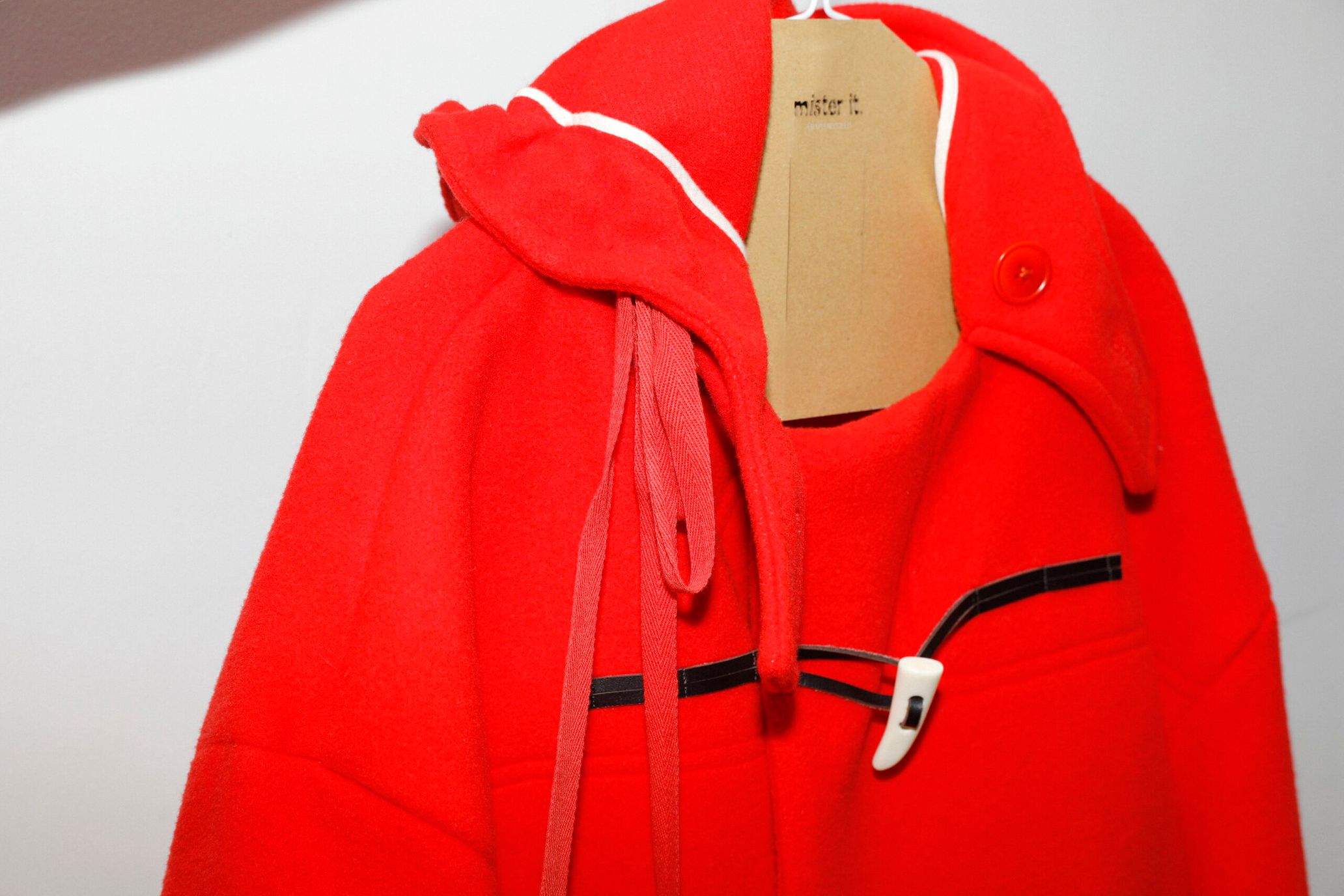mister it. designer Takuya Isagawa was greatly influenced by his father, a professional scarf maker, and his mother, an oil painter. Naturally, he developed an interest in fashion from a young age. Yet, he spent most of his teenage years focusing on soccer rather than fashion.
But a moment came where he decided to give up on soccer, a sport that was supposed to be his passion. During a game in his second year of high school, he became acutely aware that there was a clear difference in level between those who could go pro and those who couldn’t. At that moment, Takuya made a mental shift, deciding to make moves towards his next goal.
“I don’t want to have any regrets about whatever I do next.”
With soccer, Takuya had a strong feeling of regret about how he could have done things differently back then. Later, this feeling would become a driving force to pave his path. That’s how his journey into fashion, something that had been familiar to him since childhood, seriously began.
After moving from Osaka to Paris and gaining experience at the maison he’d always wanted to work at, he launched his brand, mister it., in Tokyo in 2018. I’d like to open this interview by asking him about his experience living in Paris.
Clothing is made by a team, not an individual
――You started university at ESMOD in Osaka, and then went on to study abroad at ESMOD Paris. After graduating, you began your career at Maison Margiela. I heard that you memorized your self-introduction in French before your interview there.
Takuya Isagawa(from hereunder, Takuya): At the time, I couldn’t speak any French at all. So I had a friend who could speak Japanese and French translate my self-introduction into French. Then I asked him to read the French self-introduction aloud so I could record it. I listened to that recording every day and was able to memorize it through repetition. Before I knew it, my pronunciation was perfect. (laughs)
――(Laughs). I’d assume that they asked you all kinds of questions during the interview. How did you respond?
Takuya: At the time, I responded to everything with “oui” [yes] and got through it with laughter. (laughs) However, within five minutes of passing the interview and getting the job, they realized that I couldn’t speak any French at all.
――What did you do from there?
Takuya: Every evening after I got home from work, I practiced telling anecdotes in French. Not just any anecdotes, but funny stories about mistakes that I’d made. Yeah, I’d think of an anecdote that would make people laugh, and I didn’t care if my French was wrong. I’d practice every night with the thought that I’d tell this anecdote no matter what the next day. And then the next day, I’d talk about it at work. I kept this up daily, and before I knew it, I started being able to hold conversations in French.
――What kind of work were you involved in at Maison Margiela?
Takuya: I joined the company as an intern, and right after I started working there, the head designer told me, “At this brand, whether you’re an intern or an employee, the interesting ideas will rapidly take shape. So we want you to keep bringing new ideas to the table without hesitation.” It’s much more motivating to be in an environment like that, where ideas are valued more than seniority or position, isn’t it? Whenever I was asked to do something, I didn’t give it 100%; I gave it 200%. That was what I always did.
――And that’s how you earned their trust.
Takuya: Three months into my internship, the president of the company called me in and asked me, “Takuya, what do you want to do in the future?” I told him, “I want to have my own brand in the future, but until then, I want to stay in Paris.” And then my boss said, “Well then, you’re a full-time employee now.” And from that moment on, I was in charge of the collections and haute couture. But one thing I can say is that I didn’t design any pieces completely on my own. We crafted the clothes with everyone on the team adding their ideas to update the pieces, and that turned into the clothes. That was how we did it. So there isn’t a single item I can say I did from start to finish on my own.
Takuya’s collection started from a desire to convey his gratitude
――Could you tell us about the brand concept behind mister it.?
Takuya: If I had to describe it in a few words, it’d be “accessible haute couture.” When people think of “haute couture,” they have this image of clothing that’s made for celebrities walking down the red carpet. I’ve had experience making that kind of clothing, and I came to think that I wanted to make haute couture more accessible. I think about the people close to me and what kind of clothes would make them happy. So if I make clothing that way, and that clothing reaches people who identify with it, that would make me really happy.
――Even though you were involved with Maison Margiela, a major fashion brand, mister it.’s concept is inspired by real people you meet, which is very interesting.
Takuya: I want clothing to be familiar rather than a distant concept, so I want to make clothing that’s accessible. In the mister it. collection, I make clothes that look like art pieces, but that’s intentional. It’s not that I want people to actually wear art pieces on the street. Rather, I want people to enjoy looking at the clothes, like, “Oh, clothing can look like this” or “Clothing can be made like that, too.”
――Before you actually launched mister it. in Japan, you created your own collection in Paris. What was that collection like?
Takuya: After putting some thought into how I’d launch my brand, I wanted to properly pull off Zero. I wanted to show all the people I’d been working with at the time my gratitude for everything. So I titled it “Collection Zero” and crafted pieces that were specifically for the people I’d been working with. And then I gifted those pieces to them.
――How did you present Collection Zero?
Takuya: I rented out a shop in Paris and had everyone get together there. In front of everyone, I presented the clothing to each person, telling them, “This piece is yours. I made it especially for you.”
――What was the response like?
Takuya: Everyone was very happy. Yeah, how do I say this—basically, everyone was just very happy, and really moved by it.
――You must have been happy to see everyone’s reactions too.
Takuya: I was very happy. Really, truly happy. I didn’t want to think of anything more than what was necessary. I simply made it to say thank you. That was all I wanted to do. To be able to do that was really amazing.
Clothing inspired by people and overflowing with love
――What’s the theme of the 2021 AW collection?
Takuya: It’s a collection that’s very conscious of focusing on the people who make the pieces. The collection truly came together with the work of so many people—the people who make the fabric, the people who make the thread, the people at the sewing factory—so I wanted to incorporate the creators into the theme a bit.
――When I went to the exhibition, there was some kind of background music playing of people talking. Whose voices were they, and what were they talking about?
Takuya: I wanted to collect something from all the people who were involved in the making of this collection. So I figured that voices would be a good way to do that.
――So you mean the voices in the background were the voices of the people who made the clothes?
Takuya: Right. I recorded the voices of so many different people—the people who did the printing, the people from the sewing factory, the people who were involved in the photoshoot—and then at the exhibition, I played those voices as if it were an installation. There, I made it so that people could hear the voices coming from behind the clothes. I also played the voices from underneath where the lookbook was placed.
――But the voices I heard at the venue didn’t sound like Japanese…
Takuya: I didn’t want to make it that serious; I wanted to make it catchy. So I purposely had the creators speak in English. In katakana English [adjusting English words to a Japanese pronunciation], I had them say just a few words on what kind of clothing they had made, saying, “I made so-and-so thing.” At the venue, it may have sounded like one person talking a lot, but it was actually a lot of people talking, with each person saying just a few words.
――In the 2021 AW Collection, you presented a blouson with a daring print. This powerful print almost looked like a painting. What is the print depicting?
Takuya: The print portrays a scene of the people who were the theme of Collection Zero actually working in the Paris atelier.
――The blouson looked like a painting that used the clothing as a canvas. I was really surprised by how powerful it was. The print truly conveys the theme of this collection: the creators.
Takuya: I wanted to make it straightforward and vigorous. And the result was this print.
――The coat was impressive too. It looked like a trench coat, but it also gave off the impression of a soutien collar coat, while feeling like a duffel coat at the same time. How did you come up with the idea for that coat?
Takuya: Regarding that coat, someone once gifted me a blouson made of the same melton fabric as the coat from this collection. That led me to think that it’d be nice to respond with a jacket that was the same color as the blouson. I made that coat with that thought—like I’d be returning the gift.
――The ribbons and other details on the coat are interesting.
Takuya: I think a unique characteristic of mister it. is that it can be worn with many different looks. Sometimes, depending on your mood that day, you might want to wear the coat with the waist cinched. Other times, you may want to wear it loose. Even a slight change in how you’re wearing it can make it look quite different. This coat is also reversible, and when you turn it inside-out, you can see the white piping detail.
――When it comes to mister it., the shirts really stand out; The small black heart on the cuff of the classic shirt leaves an impression. Do the shirts from the 2021 AW Collection have any new features?
Takuya: I put a small heart on the cuff so when you see a friend for the first time in a while and go to shake their hand, it comes into view. That heart becomes an opportunity for communication. That was how I wanted people to use the shirt. But with the pandemic right now, I think that even if people meet with their friends, they might feel uncomfortable or reluctant to shake hands. So I thought it’d be appropriate for now to get a glimpse of the heart when you nonchalantly reach in your pocket for something, for example. So as an extra detail, I added another placket on the inside of the shirt, like an inner belt, and printed a small heart onto it.
――So you want your clothing to reflect the current mood of the world?
Takuya: Rather than create things in response to trends, I want to create things that are conscious of what we need to do as a brand or what works for our modern world. For example, the base shape of a shirt really hasn’t changed in hundreds of years. Yet, the way we go about our lives with the shirts we have now versus the shirts people had hundreds of years ago is definitely different. So I think it’s strange to have the same details and features today. But the outline and base of a shirt are great, so I try to update that by adding my brand’s vision of the present while still keeping that basic feel.
The story lies within the minds of the people who wear the clothing
――So you wanted to create the brand’s vision of the present. Now that the coronavirus has changed the world and our situation, could you talk about your vision and thoughts regarding what kind of clothing mister it. wants to create in the future?
Takuya: It goes without saying that I’ll keep updating the clothes. But more than that, there’s something else that I want to be conscious of. And that’s designing not only the clothes, but also designing how to deliver the clothes to people.
――Do you mean something like an online store?
Takuya: No, not exactly an online store. Rather, I want people to wear my pieces for a long time, so I think a lot about how I can have people do that. That’s why I’ve devised little tricks. For example, the coat we discussed earlier has a custom mister it. hanger, which is a regular wire hanger with a cover.
――That’s interesting. It makes an everyday wire hanger look special.
Takuya: I started out with the idea of making a hanger, and that led to the idea of making a hanger cover. I think a wire hanger is something that most people have, but by putting a cover on that sort of everyday hanger, it becomes more personal. If there’s a place where the piece belongs, perhaps people will cherish it for a long time. I think people will definitely put a piece back in its place if there’s a designated place for it to return to.
――So you mean if there’s a place you want to return the piece to, people will cherish the piece and wear it for a long time?
Isagawa: You can also remove the hanger cover. You can expand the shape and insert a single flower into the hole, too. For example, if you put a shirt into a box with a hanger cover that has a flower inserted into it and gave it to someone as a gift, I think the recipient would be happy upon opening the box and seeing the flower and shirt. I think this way of delivering clothing itself needs to be designed.
――That’s an incredible idea. If I got a piece like that, I’d personally want to treat it with care.
Takuya: Generally, I think long-lasting clothing is about the quality of the tailoring or how basic it is. But I think mister. it clothes can be worn for a long time because they have an emotion or a story built into them. Actually, since last season, I’ve been trying to avoid telling a personal story. An idea starts with the person who inspired it and a story. But I want the people who actually wear the pieces to create a story that’s unique to them. It’s not that I’m just leaving it up to them, but I’ve come to think it’s ideal for the wearer to wear it how they like and create their own story without me telling them too much.
There was one thing from this interview that left quite an impression on me: Takuya’s actions after he started working in Paris and his colleagues realized that he couldn’t speak any French. At the time, Isagawa started preparing funny anecdotes to laugh at himself. Although he was in crisis, he chose humor. I think that attitude is precisely what mister it. is all about.
In a world that can be serious and harsh, sometimes, a smile can save the day. Isagawa brings smiles to people’s faces by incorporating humor into fashion. He has a kind sense of humor that never hurts anyone, which is combined with the elegance he refined in Paris. At the end of this interview, there was one question I asked: “What kind of moments make you happiest while making clothing?” I’d like to conclude with his answer to that question. It’s clear that mister it. loves people.
“I want my creations to reach customers and make them happy, that’s it. That’s what it’s all about.”
Takuya Isagawa
After attending ESMOD Osaka and graduating from ESMOD Paris, Isagawa started mister it. in Tokyo in 2018. By dynamically combining form, material, color, and the other elements that make up clothing, he designs clothing at the intersection of fashion and realism. His collections combine elegance and humor, with a diversity that transcends gender and seems to bring out people’s charm.
http://misterit.jp
Instagram:@misterit75003
Photography Shinpo Kimura
Translation Aya Apton










